What is market segmentation and why is it so important?
The success of a business relies on offering the right product to the right consumer at the right time.
To do this, marketers need to know their customers inside out. This makes market segmentation a vital tool for organizations to study and segment consumer behavior—one that can reap huge dividends.
Updated on 22 Mar 2024
A Harvard Business School survey conducted in the US found that 95% of new products fail due to ineffective marketing segmentation.
Every consumer comes with unique requirements, so a one-size-fits-all marketing strategy won’t work to engage users across the board. Marketing segmentation helps companies divide users into unique groups to analyze their needs and communicate with them effectively. This gives organizations a competitive advantage and improves Return on Ad Spend (ROAS).
What is market segmentation?
Market segmentation is the process of dividing a larger market into smaller groups of consumers with similar characteristics, needs, or behaviors. By identifying and targeting specific segments, businesses can tailor their products, services, and marketing efforts better to meet the needs and preferences of their target audience. This is what we mean by segmentation in marketing.
Why is market segmentation important?
Market segmentation is crucial for businesses to develop the right customer persona and effectively target their desired audience and tailor their marketing efforts. By dividing a larger market into smaller groups, companies can create more personalized messaging, improve customer satisfaction, and ultimately increase sales and revenue.
Combining market segmentation with advanced website personalization greatly increases customer loyalty and revenue and helps brands deliver exceptional customer experiences.
What are the benefits of market segmentation?
The three main benefits of market segmentation are:
- Targeted marketing: By dividing a larger market into smaller, more defined segments, businesses can create more personalized marketing messages and target their desired audience more effectively.
- Improved customer satisfaction: By understanding the specific needs and preferences of their target audience, businesses can tailor their products and services to better meet customer expectations and ultimately improve customer satisfaction.
- Increased profitability: By targeting the right customers with the right marketing strategies, businesses can improve their conversion rates, increase customer loyalty, and ultimately increase their profitability.
⭐️⭐️⭐️⭐️⭐️
“Insider’s segmentation tool helped us segment our huge customer base with ease!”
—Digital Marketing Manager
Read more reviews from happy customers on G2.
What is target marketing?
Target marketing is a strategy that involves identifying a specific group of consumers that a business wants to reach with its products or services. By understanding the needs and preferences of this target market, businesses can create more effective marketing campaigns and improve the chances of attracting and retaining loyal customers.
Target marketing can also include identifying which regions your customers are based in. With such knowledge, you can adapt your marketing and sales strategies accordingly.
For instance, if you want to enter the European market, you will need to focus on specific countries in Europe in which your target customers live.
Thankfully, you can easily gain the data, applications, and insights you need to win any European market with the products, solutions, and resources from Dealfront.
What is market positioning?
Market positioning is a strategic exercise that outlines the USP of a product and highlights what makes it better than its competitors. This exercise is a basic tenet of every marketing story, which works at three levels:
- Find out who the right audience is.
- Understand their needs and desires.
- Build a marketing strategy that explains how your product is the best fit for them.
The better a product’s positioning, the higher its chance of business success.
What is the relationship between market segmentation, target marketing, and positioning?
Market segmentation, target marketing, and positioning build a well-rounded marketing strategy. All three rely on each other to perform a perfect marketing masterstroke.
Market segmentation categorizes a customer base according to their interests. This helps marketers target potential customers with relevant products. This helps optimizes their marketing strategy.
Once marketers have the relevant data on customers and their requirements, they can position their product in a way that ticks all the boxes for the user. This combination of all three marketing tactics combined helps businesses to increase conversion rates and drive growth.
See why top brands trust Insider — try our product tours at your own pace.
What are the different types of market segmentation?
There are four broad types of marketing segmentation based on unique attributes. Each is subdivided into smaller categories to serve them better. These four types are:
- Demographic segmentation
- Psychographic segmentation
- Behavioral segmentation
- Geographic segmentation
Demographic segmentation
Demographic segmentation is the simplest and most generalized segmentation category. It creates large groups of people based on age, gender, religion, location, or occupation. For example, beauty cream is more relevant to women aged 16 to 35 than men in their 80s.
Psychographic segmentation
People who think alike usually shop alike—and psychographic segmentation groups users based on attitudes, lifestyles, interests, or values. Though psychographic segmentation isn’t as simple as demographic segmentation, it gives marketers deeper insights into their audience.
For example, if a consumer is highly concerned about the privacy features of her smartphone, she might opt to buy an iPhone.
Behavioral segmentation
Marketing expert Jon Miller said: “Knowing who your customers are is great. Knowing how they behave is better.” Behavioral segmentation divides customers based on patterns of behavior displayed by customers as they interact with a company or make a purchase decision.
For example, buying patterns of a user, brand interaction, website interaction, engagement on an app or website, and loyalty.
Geographic segmentation
Geographic segmentation segments people based on geographical boundaries. Besides geographic location, factors like climate, cultural preferences, and urban-suburban-rural divides are also possible.
How to develop a marketing segmentation strategy: step-by-step
Now you understand market segmentation theoretically, let’s dive into how it works in practice. Here’s a step-by-step guide to developing marketing segmentation strategies:
1. Analyze existing customers
This will help marketers understand customer behavior, for example:
- Get feedback: Ask customers about their experience with your product.
- Brainstorm with the sales team: Your sales team spends the most time talking with customers, so use their insights as a critical resource.
- Analyze website analytics: Your website has tons of data (such as time spent, bounce rate, and key pages). Use these metrics to better understand your customer and engagement levels.
- Analyze audience interest: If a consumer visits your website to explore a particular product category, put them in the concerned psychographic segment.
2. Build a consumer segment group
Once you’ve understood your consumer, you can draw a complete picture of your target user group. This will help you get a 360-degree understanding of your consumer and create the right marketing strategy to target them.
3. Create brand positioning
When a marketer is clear about his potential customer, it becomes easy to position a product that addresses the user’s issues.
4. Find the right market segment
This is where you link your product’s positioning with your consumer’s requirements. For example, what problem does your product solve? Is there a customer segment that’s not having its needs met? Link the two, and find your right-fit user segment.
5. Launch your campaign
It’s time to launch your campaign. To play it completely safe, you should A/B test your campaign for optimal results.
How Insider helps brands deliver segmented marketing
Marketers mustn’t underestimate the importance of careful and thoughtful market segmentation to ensure they target the right customers with the right marketing strategies.
To do this, marketers need to ask some critical questions:
- Who are our current and potential customers?
- What are their specific needs, interests, and preferences?
- How do they interact with our products or services?
- What is the best way to reach and communicate with them?
Insider’s customer data platform (CDP) helps brands answer these questions. Our technology can help marketers create the right customer segment groups and engage with them using the right tools.
⭐️⭐️⭐️⭐️⭐️
“Insider helped us boost our revenue even in the most lull season with Web Suite of products. Right segmentation and sending relevant campaigns to the right audience can turn even a dull sales season into Christmas. With Insider’s Web Push, we were able to send notifications to customers on products that were back in stock and available at heavy discounts off-season.
This helped in generating more sales than usual even in the dullest season of the year business-wise. The icing on the cake was deep segmentation and automation of the entire campaign which enabled us to nudge the customers.”
Read more reviews from happy customers on G2.
Insider is a powerful platform that offers various tools and features to help brands segment their audience and improve their marketing efforts. One of the key benefits of using Insider is its advanced segmentation capabilities, which allow brands to divide their audience into smaller, more defined groups based on specific criteria. Let’s look at how:
High-converting predictive segments
Fed up with low conversion rates? Insider lets you create intelligent segments that speak to individuals on their level—factoring in discount affinity, likelihood of purchase, lifecycle stage, and more in real-time thanks to Insider’s powerful predictive engine.
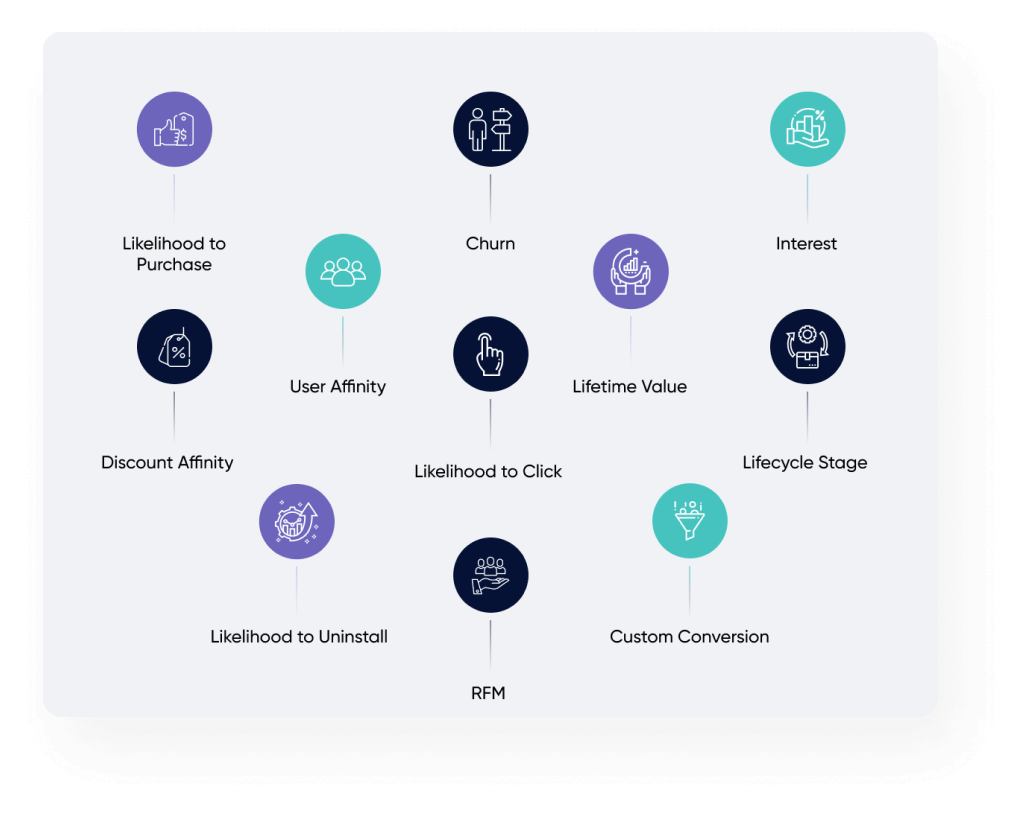
Segment users based on real-time events
Never miss out on a micro-moment opportunity to delight your users with segmentation available based on real-time events, such as cart abandonment and installs.
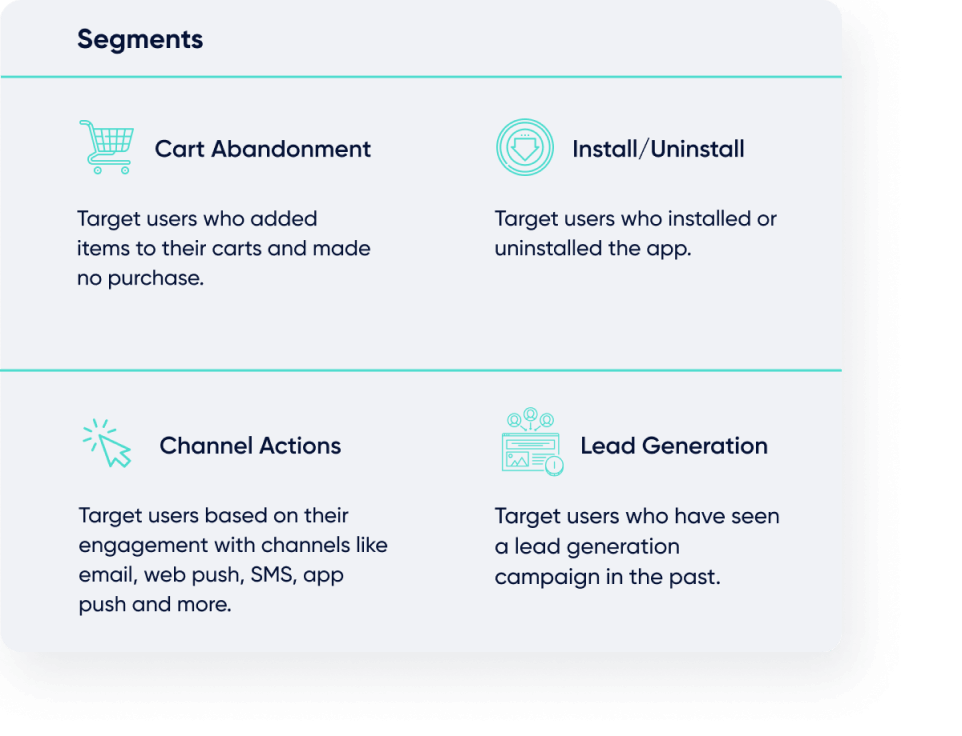
Flexibility
One of the best features of Insider’s segmentation tool is its flexibility. Brands can choose from various segmentation criteria, including demographic, behavioral, geographic, and psychographic factors, to create highly targeted audience segments. This allows brands to understand their audience better and tailor their marketing strategies accordingly.
Simplicity
Insider offers an intuitive, user-friendly interface that makes it easy for brands to create and manage audience segments. Brands can also set up automated workflows and triggers based on specific audience segments, which can help improve the efficiency and effectiveness of their marketing campaigns.
And more!
Insider also offers a range of other tools and features to help brands improve their marketing efforts. For example, the platform offers advanced personalization capabilities, allowing brands to deliver highly personalized content and experiences to their audience based on their interests, preferences, and behaviors.
Insider also offers powerful testing and optimization features, allowing brands to test different variations of their campaigns and optimize their performance based on real-time data and insights. This can help brands improve conversion rates, increase customer engagement, and drive more revenue and growth.
Insider is an excellent choice for brands looking to take their marketing to the next level.
Market segmentation examples
Let’s look at some market segmentation examples powered by Insider’s advanced market segmentation software.
Example 1: Re-engaging users with predictive segmentation based on behavior
Let’s take an example of a finance company with an app selling services like loans, insurance, and mutual funds. It’s a leading industry brand, and thousands of users have downloaded its app, but competition is stiff. The company realizes many VIP users are uninstalling the app and switching to a rival company.
Existing customers switching to a rival company will directly impact Customer Lifetime Value (CLTV). After all, it costs less to keep existing customers than to acquire new ones. So, how can they convince someone they should stay?
Using Insider’s Predictive Segments and App Tracker, the finance firm tracks its users’ online behavior to determine if they follow a competitor’s application. If yes, the user is added to a high “likelihood to uninstall” segment.
But the company doesn’t want to lose a consumer to a rival brand at any cost. So they use Insider’s Architect to re-engage the customer.
- If users opt-in to Email, they send a strong email offer to encourage them to re-engage.
- If the user does not opt-in to Email, the brand sends an App Push notification specifying new product arrivals and offers.
- Then, if the user still does not act, they send a Facebook remarketing message.
This cross-channel orchestration, powered by Insider’s Architect, highlights the ongoing relationship between the consumer and the brand, highlighting the special deals available to long-term clients. This multisegment marketing strategy makes the customer feel unique—and they opt to remain on board.
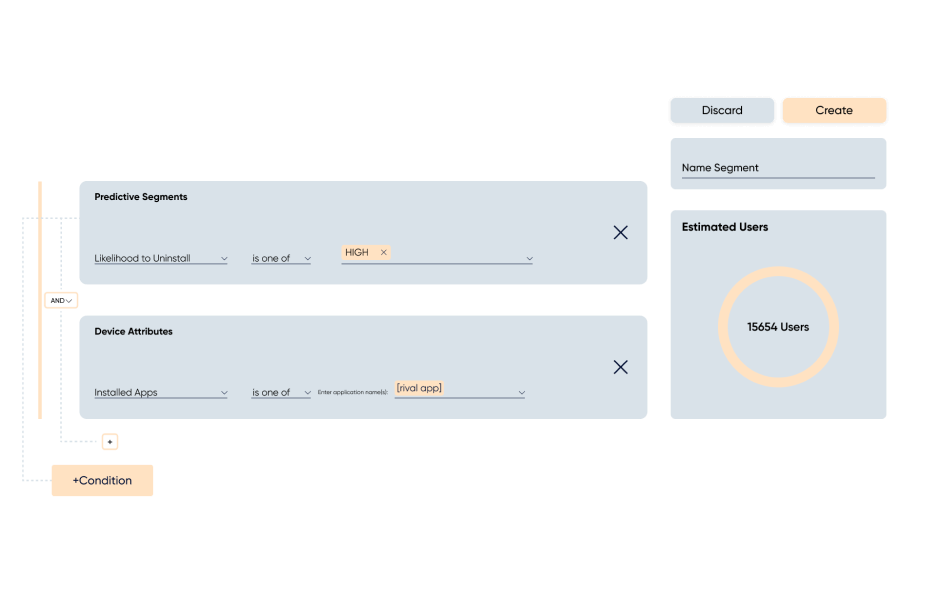
Example 2: Encouraging browsers to purchase
Let’s now take the example of a travel company that offers customized holidays, hotel bookings, and flight tickets through its website. During one of its audits, the company discovers a large base of users who visit the website, browse holiday destinations and airfares but don’t book anything. Annoying, huh?
But one thing is clear; this user segment is highly likely to purchase. They want to go on that holiday to Egypt or Greece but seem to have a change of mind at the last minute. The company decides to engage with them to get them to convert.
First, they create a segment of consumers who visited the website more than five times in one week. Next, using Architect, they send Web Push notifications offering hotel deals and cheap airfares. If there’s still no response, they try to engage via Email perhaps even sending a digital flipbook showcasing travel destinations.
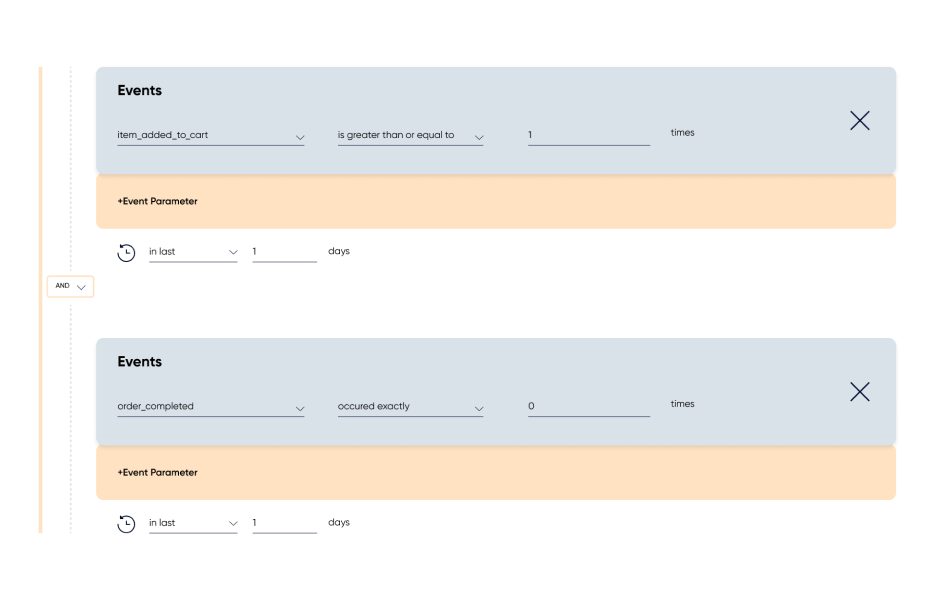
The Email strategy works, and the user lands on the website. Insider’s Onsite Smart Recommender takes over from here—showing a personalized webpage based on their travel interests. As the users revisit the page, Smart Recommender’s Shuffling application shuffles the categories, showing users new products on every visit. The personalized website experience increases conversion rates.
Example 3: Reducing cart abandonment by creating urgency
Thousands of shoppers go online to shop with an eCommerce retailer that sells everything from electronic items and smartphones to shoes and clothes. However, the company notices a growing number of cart abandoners on the site, with many users adding items from a specific product category to their cart but not purchasing—or returning for a few days.
Besides hampering sales, this poses another problem: the item in the cart automatically reduces the stock numbers listed by the company, and they can’t show it to other customers.
The retailer sends dynamic push notifications to convert the cart abandoners using Automated App Push. When users click the notification, they land directly on the product page they’d left forgotten in the cart.
But what else could the brand do to encourage the customer to purchase? Insider’s Social Proof builds urgency around the product by posting a banner on the product page saying, “Only 10 items left in stock.” This nudges the consumer to purchase before the item they’d been looking at runs out of stock.
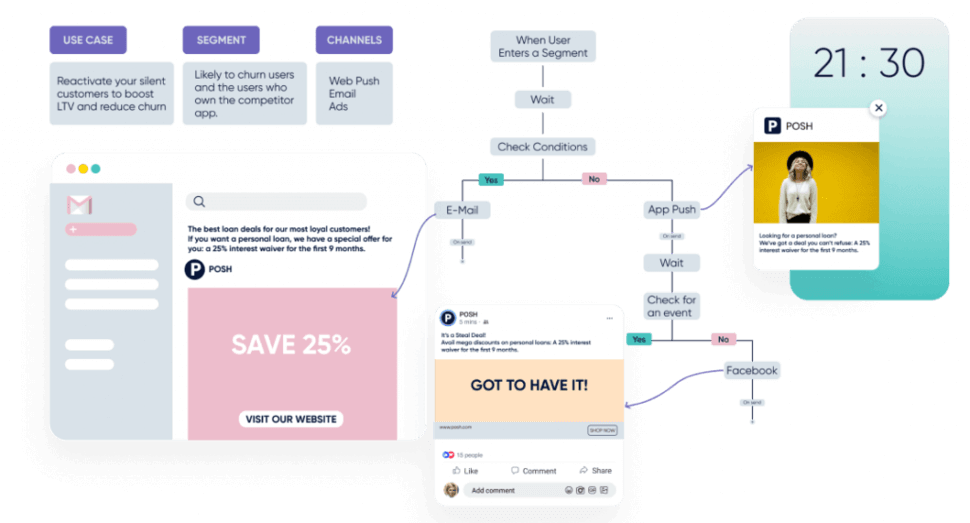
⭐️⭐️⭐️⭐️⭐️
“We won back customers with Insider’s predictive segmentation and Web Push messages. Using Insider’s predictive segmentation tool, we targeted the right user segments. We brought back users who had left our site immediately by using welcome emails and targeted users who abandoned their carts with web push notifications. We also used other tools from Insider such as personalization templates and the customer database to target the right users with push messages so that they resonate better with our customers. These helped us in the engagement strategy and we were able to see a higher number of conversions henceforth.”
Read more reviews from happy customers on G2.
Example 4: Persuading visitors to stay online with targeted exit intent
Let’s take the example of another eCommerce company. This new company has just launched its website and is looking to attract visitors to its webpage and drive sales. However, eCommerce is a crowded marketplace, and the company doesn’t want to lose consumers who land on its webpage for the first time.
They use Insider’s Exit Intent feature to capture cursor movements on the webpage. If the tool senses a user is about to click out, a pop-up shows on the webpage, offering incentives such as free shipping and a money-back guarantee.
Success! After sharing their email id, most users opt to take up the offer. This way, the startup retailer also got to build its user database.
Discover how Lexus increased lead generation by 64% with Insider’s Exit Intent feature.

Example 5: Retargeting registered users by reinforcing benefits
As a global fitness fad gains momentum, a fitness app saw the number of registrations soar on its application. However, the high registration rates were not translating into an equally high number of active users.
The firm drew a marketing strategy to engage users who registered for its fitness programs but did not start a session for a fortnight. It used Insider’s Mobile App Push to send notifications to these users. Not only did the notifications talk about the various workout programs and free online classes offered, but they also highlighted the importance of staying fit to lead a meaningful life. The idea worked wonders with consumers.
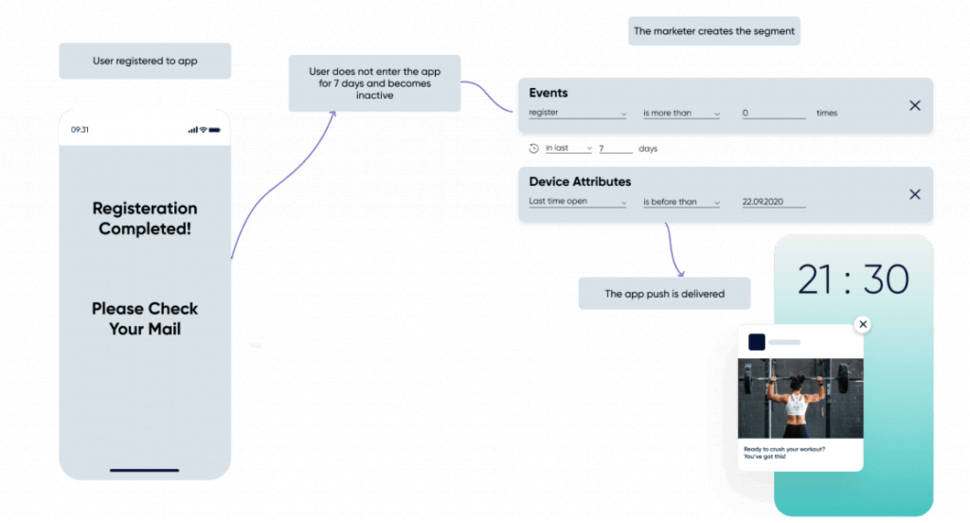
Insider is the right market segmentation software for you
Insider offers a comprehensive marketing platform with advanced segmentation capabilities that make it the right market segmentation software for businesses of all sizes. With Insider, businesses can take advantage of advanced segmentation tools to create highly targeted audience segments based on a wide range of criteria, including demographics, behavior, geography, and psychographics.
⭐️⭐️⭐️⭐️⭐️
“Insider’s predictive segmentation tool proved to be a revelation for us. We leveraged Insider’s predictive segmentation to help us with our Instagram ads. We noticed we were able to turn things around with Insider and increase our conversions within a very short span of a few weeks. Insider’s predictive segmentation feature is awesome and there is nothing about it we don’t like.”
— Digital Marketing Manager
⭐️⭐️⭐️⭐️⭐️
“Insider’s segmentation made our email campaigns powerful and proved to be a winner for us. Insider’s RFM and predictive segmentation helped us target our loyal customers and provide them with the experience they deserve. This coupled with the email tool we used helped us deliver successful campaigns with content that was gorgeous and actionable at the same time.”
— Digital Marketing Specialist
Read more reviews from happy customers on G2.
Ready to learn more? Schedule a demo
Frequently asked questions
Audience segmentation can enhance inbound marketing efforts by allowing businesses to create more targeted content, improve lead nurturing, and increase customer engagement and retention.
Segmentation, targeting, and positioning are three key concepts in marketing that involve dividing a larger market into smaller segments, targeting specific segments, and positioning products or services to meet their unique needs.
To segment a market, businesses can use various criteria such as demographics, behavior, psychographics, geographic location, or customer needs and preferences, and divide the market into smaller groups with similar characteristics.



















